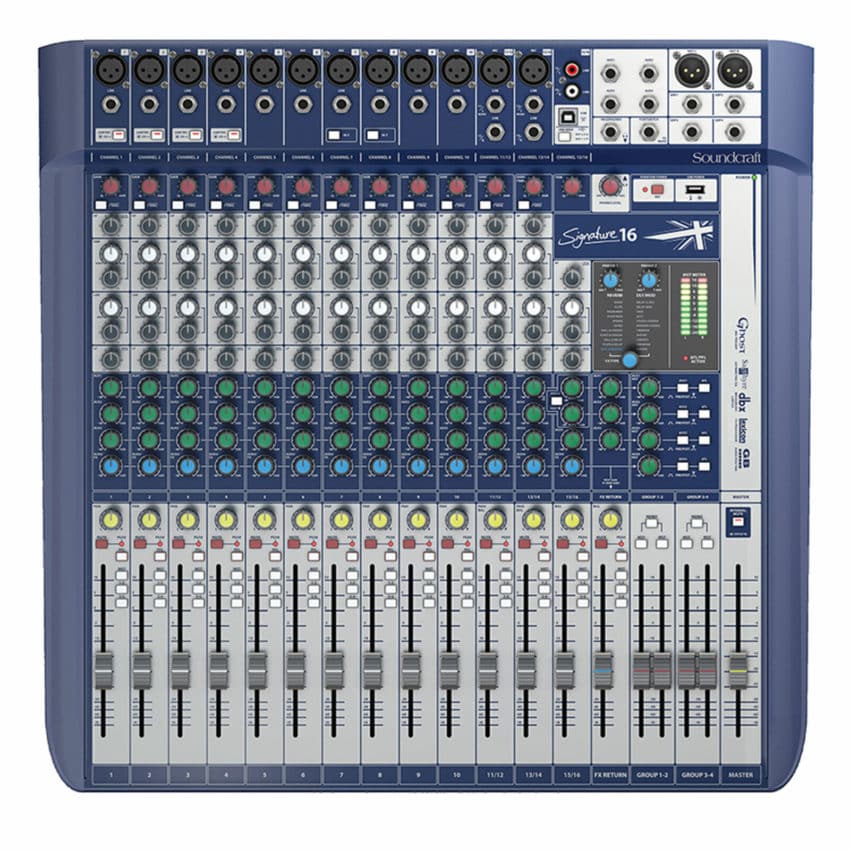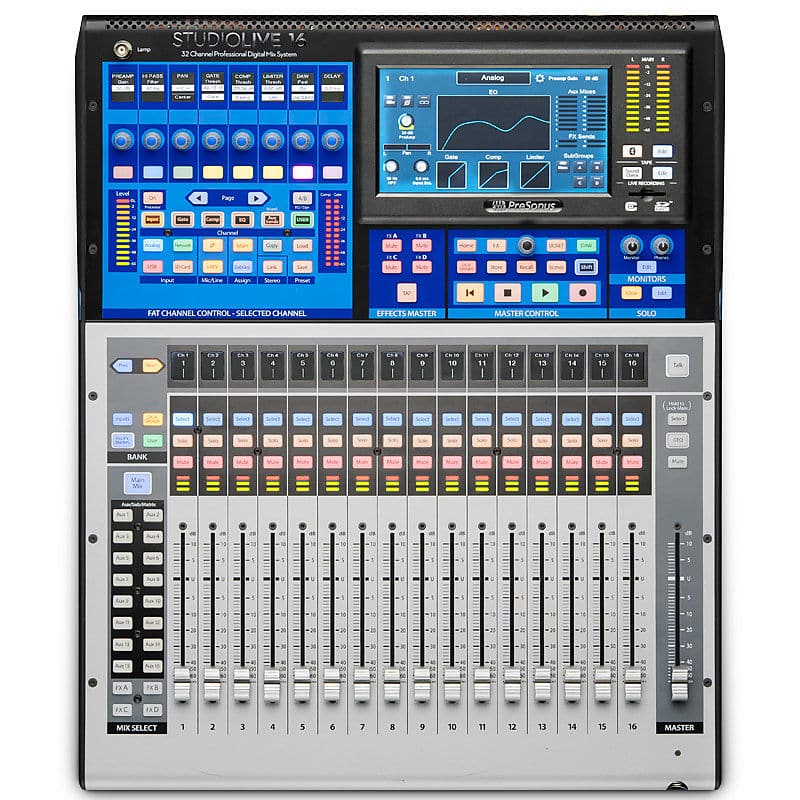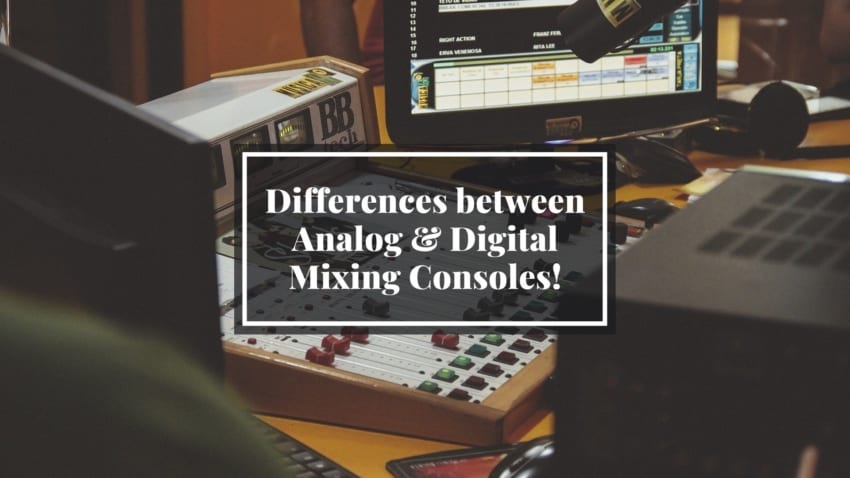Last updated on February 22nd, 2021 at 01:21 pm
The job of a mixer is to take all the incoming signals, mix them and then send them to one or more destinations.
Analog and Digital consoles, while essentially doing the same thing, work in a very different way, and this is what I will cover in this article.
Make sure to check the table at the end of the post for a quick summary of what each of them do.
Analog Vs Digital Mixers
In short;
With analog mixing consoles, what you see is what you get; meaning that all the processing of the audio is done by the controls you see on the channel strips, making the workflow fast but often limited.
On the other hand, Digital Mixing consoles come with a lot more features, such as effects, but accessing them isn’t as fast since you have to select one channel and then add all the effects before moving on to the next one.
For a fast workflow, analog mixers tend to be better, while digital mixers are more versatile.
Analog Mixers

Analog consoles follow a more “hands-on” approach that makes the workflow very fast and intuitive.
They might seem intimidating at first because of all the knobs that they have, but these controls are actually organized in a very simple-to-understand way, since all the controls on channel one are identical to the controls on channel 2, and these are called “channel strips”.
Once you learn what all the knobs on the first channel strip do, you basically know how the entire console works.
Now, analog consoles are generally more affordable than digital ones, and this is because they lack the huge number of features that digital ones are able to provide thanks to their internal digital processing power.
However, despite being more affordable, they usually require external hardware to add processing and effects since they don’t have these built-in, and purchasing all that extra gear definitely adds up.
Not only that, but touring with an analog mixer can be quite more difficult than with a digital one because you will need to take all that outboard gear like compressors, graphic EQs, etc. with you.
Additionally, as far as the routing of the audio goes, they are not as flexible as digital consoles since you can’t take “Input 1” and route it to a different channel; What you see is what you get, but this also means that it’s much simpler and faster to work with an analog mixer.
One last point to make is that dust and dirt can affect the faders and the knobs, which can make these mixers more susceptible to noise, and this doesn’t happen within a digital environment.
Basically, if you want a fast workflow and instant access to all the controls but don’t mind either taking outboard gear with you or simply don’t need all that extra processing power that digital mixers can provide, then an Analog Console is what you need.
Read also: Best Home Studio Mixers; Analog & Digital.
Digital Mixers

With digital consoles one could say that you also get that instant access to all the controls like faders, and other simple processing (this depends on the mixer itself), but you also have the ability to access a lot more processing power that comes built-in with the mixer.
However, this has to be done on a channel-by-channel basis, meaning that you have to select the channel you want to process and then go into a menu to select the effects you want to add.
One difference with analog mixers is the routing; you can select where to route each input, and in fact you can even layer multiple inputs, meaning that you can control a large number of input channels via a handful of faders by arranging them in fader layers.
One feature that is worth noting about digital consoles is that they can store your different setups as presets:
You may have three different bands playing at a venue and instead of manually moving the faders like you would on an analog console, you can save the settings for each band as presets and recall them with the press of one button.
In addition to having many more effects than analog mixers, some digital mixers even offer amp simulation, meaning that taking a guitar or bass amp to the gig might not be as necessary anymore.
Where digital mixers excel the most, at least in my opinion, is the remote-control feature; most of these consoles allow you to control the mixer with an app via an iPad or Tablet device, and you can connect multiple of them at the same time.
Not only does this come in handy for the engineer since he/she can move around the venue to listen to how the mix sounds, but every musician can connect to the mixer with their wireless device as well and control their own headphone mix.
Lastly, and this point is extremely important if you are thinking of getting a mixer for a home studio, digital consoles can often be used as control surfaces for different DAWs, allowing for a much faster and intuitive workflow.
In short, a digital console adds a lot more versatility but makes the workflow slower in most cases.
One Important Factor
I believe that a mixer that is designed to be used in a home studio should be capable of multitrack recording; this means that every input can be recorded to a separate track in the DAW.
There are many mixers that are capable of doing this, be it analog or digital, and some can also record to an SD card (some mixers can do both at the same time).
This way you are allowed to record multiple instruments and have full control over the tracks later on in the DAW, instead of just being able to record the stereo out of the mixer.
So, keep that in mind, since most affordable mixers can’t do this, even if it says that they feature a USB Interface, this doesn’t mean that they can record each channel independently to your DAW.
Differences
| Console | Price | Routing | Adjusting Settings | Setting up Sends | Built-in Effects | Accessing Effects | Setting up Groups | DAW Control | Preset Recall |
|---|---|---|---|---|---|---|---|---|---|
| Analog | $ | Inputs correspond to their channel. | All the controls you can access are on the Channel Strip (more Limited). | Assigned with knobs on each channel strip (fast). | Few, if any. | Usually assigned to one of the auxiliary send buses | Usually via button on the channel. | No | No |
| Digital | $$$ | Inputs can be assigned to different channels. | More processing available, but via a menu on an individual channel basis (more versatile but slower). | Set up from the master section by setting the channel layout. | Depends on the mixer, but more than analog consoles. | Since they feature so many built-in effects, there’s rarely any need to use outboard gear. You can do this via an assignable Send, however. | Far more flexible. | Yes (not all consoles). | Yes |
How to choose the right Mixer?
This will certainly differ depending on what you plan to use the mixer for:
If you’re planning to use it in a venue where different bands play every night and you need to make quick adjustments to get the sound up and running as fast as possible, then an Analog console is definitely the way to go.
On the other hand, if you’re touring with the same band, then having the option to save the settings as presets will probably yield much quicker results since you can simply recall those settings right before the show starts.
Lastly, for a home studio setting, I think that digital consoles can work the best, but mainly because of the DAW control feature.
For most home studios however, you may actually not need a mixer but rather an Audio Interface.
If you want to know more about the differences between an Audio Interface and a mixer, then make sure to read this post I wrote about that topic.
Conclusion
For most live applications, I think that analog consoles win, especially if you’re using it to mix different musicians/bands over the course of the night.
They are also more affordable in general!
Digital consoles however, offer more bang for your buck and give you the option to use the large amount of built-in processing that they have, effectively reducing the need of carrying outboard gear with you.
I hope this information was useful!
Have a wonderful day!
